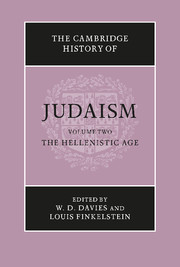Book contents
- Frontmatter
- 1 The archeology of Hellenistic Palestine
- 2 The political and social History of Palestine from Alexander to Antiochus III (333–187 B.C.E.)
- 3 Hebrew, Aramaic and Greek in the Hellenistic age
- 4 The Diaspora in the Hellenistic age
- 5 The interpenetration of Judaism and Hellenism in the pre-Maccabean period
- 6 The men of the Great Synagogue (circa 400–170 .b.c.e.)
- 7 Pharisaic leadership after the Great Synagogue (170 B.C.E.–135 C.E.)
- 8 Antiochus IV
- 9 The Hasmonean revolt and the Hasmonean dynasty
- 10 Jewish literature in Hebrew and Aramaic in the Greek era
- 11 Jewish–Greek literature of the Greek period
- 12 The Apocrypha and Pseudepigrapha of the Hellenistic period
- 13 The book of Daniel
- 14 The matrix of apocalyptic
- 15 The Septuagint and its Hebrew text
- 16 The Targumim
- 17 The Samaritans
- 18 The growth of anti-Judaism or the Greek attitude towards the Jews
- Bibliographies
- Chronological table
- Index
- References
2 - The political and social History of Palestine from Alexander to Antiochus III (333–187 B.C.E.)
Published online by Cambridge University Press: 28 March 2008
- Frontmatter
- 1 The archeology of Hellenistic Palestine
- 2 The political and social History of Palestine from Alexander to Antiochus III (333–187 B.C.E.)
- 3 Hebrew, Aramaic and Greek in the Hellenistic age
- 4 The Diaspora in the Hellenistic age
- 5 The interpenetration of Judaism and Hellenism in the pre-Maccabean period
- 6 The men of the Great Synagogue (circa 400–170 .b.c.e.)
- 7 Pharisaic leadership after the Great Synagogue (170 B.C.E.–135 C.E.)
- 8 Antiochus IV
- 9 The Hasmonean revolt and the Hasmonean dynasty
- 10 Jewish literature in Hebrew and Aramaic in the Greek era
- 11 Jewish–Greek literature of the Greek period
- 12 The Apocrypha and Pseudepigrapha of the Hellenistic period
- 13 The book of Daniel
- 14 The matrix of apocalyptic
- 15 The Septuagint and its Hebrew text
- 16 The Targumim
- 17 The Samaritans
- 18 The growth of anti-Judaism or the Greek attitude towards the Jews
- Bibliographies
- Chronological table
- Index
- References
Summary
Considerable darkness shrouds the political and social history of Palestine in the early Hellenistic period between the rise of Alexander and the death of Antiochus III a few years after his defeat by Rome, a defeat which began the downfall of the Hellenistic monarchies. The very fragmentary ancient sources available mention the area of interest to us only sporadically in the context of wider politicomilitary developments. We are, therefore, forced to begin our reconstruction from these broader contexts. We gain insight into social conditions only through combining fortuitous discoveries in the field of archeology and papyri which, as in the case of the Zenon papyri, partially lighten the darkness at particular points. Information about the Jews is still more scanty, since legend and history are so closely interwoven in our primary source, Josephus. In some areas, therefore, we can only hope to draw a sketchy and to some extent a hypothetical picture, which may at any time have to be revised in the light of new discoveries. Nevertheless, there can be no doubt that within this period, which for us is so obscure, there occurred the first intensive encounter between ancient Palestinian Judaism and the superior Hellenistic culture. This clash left a decisive stamp on later development, and constitutes the significant factor of this epoch.
ALEXANDER'S CAMPAIGN AND PALESTINE (333–331 b.c.e.)
The last decades of the Persian empire had already brought for Palestine and the Jews the troubles of war. The revolt of King Tennes of Sidon (circa 354–346 b.c.e.) had affected Palestine too, for a large part of the coastal plain belonged to Sidon; and it is likely that Judah too suffered during the Persian counter-attack.
- Type
- Chapter
- Information
- The Cambridge History of Judaism , pp. 35 - 78Publisher: Cambridge University PressPrint publication year: 1990
References
- 3
- Cited by



